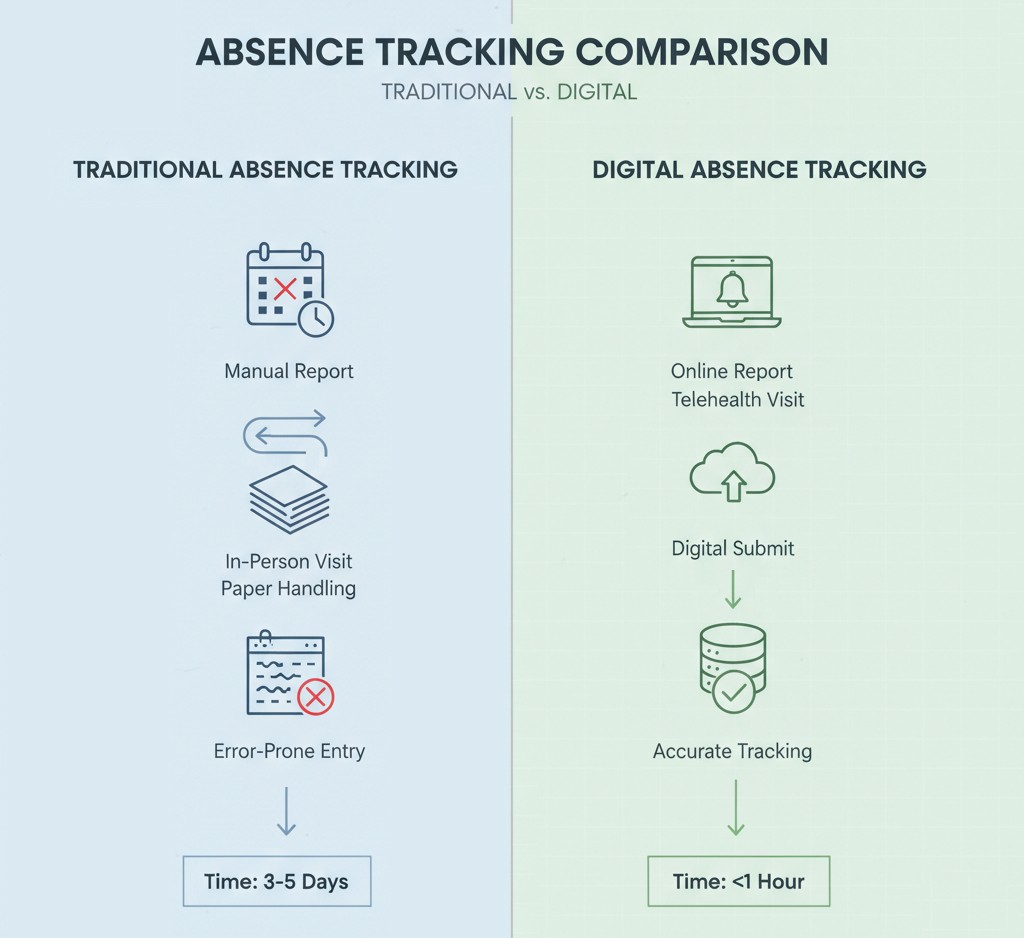Managing employee leave is increasingly complex as remote work becomes more prevalent, with projections estimating that 22% of the U.S. workforce (over 36 million Americans) will work remotely by the end of 2025. Traditional paper-based doctor’s notes and manual processes are inefficient and error-prone, but digital healthcare platforms streamline absence management with virtual doctor’s notes, enhancing efficiency and transparency for businesses of all sizes. This article explores how these tools enhance HR processes and support employee wellness.
The Traditional Absence Tracking Process
Traditionally, employee absence tracking involved manual processes that often created challenges for HR departments. Employees would report sick or personal leave, submit paper doctor’s notes, and HR would then manually enter the data into a system or spreadsheet. This system was time-consuming, prone to errors, and difficult to manage, especially in larger organizations with remote workers.
Moreover, the need for physical doctor’s notes added another layer of complexity. Employees had to schedule doctor’s appointments, wait for paperwork, and submit it to HR, leading to delays and confusion. The system didn’t always promote transparency, and employees sometimes faced difficulties when their absences didn’t follow the exact protocol. The old methods were falling short amid the rise of remote and hybrid work, particularly as more companies shift to remote or hybrid work models.
How Digital Healthcare Improves Absence Tracking
Managing employee leave is challenging, particularly with remote work. Employees still need to provide proof when they’re sick, and that’s where doctor notes for work come in. In the past, this meant scheduling an in-person visit and submitting paper notes — but today, digital healthcare makes it much easier.
Online tools let employees get legitimate documentation fast, and HR teams can track absences without piles of paperwork. These digital solutions are changing the way businesses handle sick leave and employee health.

The Benefits of Digital Doctor’s Notes for Work
One of the most significant benefits of digital healthcare tools, especially virtual health certifications, is their impact on efficiency. With these notes, HR teams don’t need to spend time chasing down paper documents or manually inputting data into spreadsheets. Everything is streamlined into one easy-to-use platform, allowing HR teams to focus on more strategic tasks.
Moreover, these virtual certifications help maintain accuracy. Paper-based systems are more prone to human error, such as misreading handwriting, entering the wrong dates, or losing documents. Digital systems automatically generate accurate timestamps and records that cannot be easily altered. This reduces the likelihood of fraud and ensures that the absence data is precise and up-to-date.
In addition to improving efficiency and accuracy, digital healthcare tools like these can contribute to better employee satisfaction. Employees no longer need to take time off from work to visit a doctor for minor ailments. Instead, they can consult a healthcare professional virtually and receive the required documentation from the comfort of their own home. This not only saves time but also reduces the stress of navigating the healthcare system.
The Role of Online Tools in Remote Work
As remote work continues to grow, the need for digital healthcare tools becomes even more apparent. Remote workers may not have easy access to a local doctor’s office or the time to take off for an in-person visit. Telehealth documentation provides a flexible, on-demand solution for remote employees who need proof for sick leave or personal time off.
For remote teams, the absence tracking process becomes simpler and more transparent with digital healthcare tools. Employees can submit their documentation online, and HR can instantly verify and log the absence in the system. This level of transparency fosters trust between employees and employers, making it clear that the company is invested in providing a seamless and supportive work environment.
Additionally, companies can use digital healthcare tools to ensure that their remote workers receive the same benefits and support as in-office employees. By adopting these virtual solutions, businesses can create an equitable system where all employees, regardless of their location, can access the same resources and services.
A Cost-Effective Solution for Businesses
Implementing digital healthcare tools is also a cost-effective solution for businesses. Paper-based systems require physical storage, time spent by HR personnel to manage documents, and sometimes, the need to outsource administrative tasks. On the other hand, digital tools save companies money by automating many of these processes. For example, companies no longer need to spend employees’ time searching for sick leave documentation or managing paperwork. With virtual notes, everything is digitized and stored securely, reducing the time and cost of administrative overhead.
Additionally, the faster and more accurate absence tracking allows businesses to avoid costly errors, such as incorrect pay or missed days.
Challenges to Consider
While digital healthcare tools offer clear benefits, businesses should also weigh potential challenges. Data privacy and regulatory compliance, such as HIPAA in the U.S. or GDPR in Europe, require secure handling of employee health information. There’s also a risk of misuse if employees obtain virtual notes too easily, potentially leading to fraudulent sick leave claims. Finally, smaller organizations may face upfront costs or training needs when implementing new systems, which should be factored into adoption decisions.
A Future-Oriented Approach to Absence Tracking
The future of employee absence tracking is undoubtedly digital. As more businesses move towards flexible work arrangements, especially remote work, digital healthcare tools will become essential in managing employee health and wellness. Virtual doctor’s notes are one step in a broader trend, with companies likely to adopt additional digital solutions to refine HR processes.
Whether it’s simplifying sick leave management or ensuring compliance with health regulations, digital healthcare is transforming how companies handle employee absences. Businesses that embrace this technology will not only improve their efficiency but also enhance employee satisfaction and create a healthier, more productive work environment. By adopting these digital solutions, businesses can save time, reduce errors, and ensure that employees have access to the healthcare they need when they need it.
Conclusion
Digital healthcare is reshaping how businesses track and manage employee absences. By streamlining documentation, reducing errors, and supporting remote teams, these tools offer HR departments valuable efficiencies. At the same time, organizations need to remain mindful of privacy, compliance, and implementation challenges. As flexible work models continue to expand, digital healthcare solutions are likely to play an increasingly important role in balancing employee well-being with organizational efficiency.












